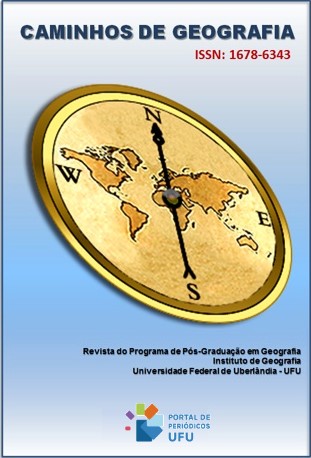ANÁLISE DA PRECIPITAÇÃO PLUVIOMÉTRICA POR MEIO DE DADOS CHIRPS E GOOGLE EARTH ENGINE
DOI:
https://doi.org/10.14393/RCG2510172626Resumo
Neste trabalho foram comparados os dados de precipitação estimados pelo CHIRPS com os dados observados em estações meteorológicas terrestres, utilizando a escala temporal mensal, além de compreender a variabilidade espacial da qualidade dos dados no norte de Minas Gerais. Complementarmente, foi desenvolvida uma rotina computacional utilizando a plataforma Google Earth Engine (GEE), para realizar análises espaço-temporal dos dados CHIRPS em escala regional, municipal e, também, em bacias hidrográficas. A extração dos dados CHIRPS foi realizada utilizando as coordenadas geográficas de cada estação terrestre do INMET/ANA, por meio de uma implementação (script) no Google Colab, obtendo-se os valores das precipitações mensais para o pixel coincidente à geolocalização de cada estação. Ainda no Google Colab, foram implementadas métricas comparativas dos dados observados e estimados. Já a rotina desenvolvida (PluvCHIRPS-V1) possui quatro módulos, estruturados por meio de programação orientada a objetos com a linguagem JavaScript do GEE. Diante dos resultados encontrados nessa pesquisa e, também, da baixa densidade de estações meteorológicas terrestres na área de estudo, recomenda-se a utilização do CHIRPS como fonte alternativa de dados meteorológicos. A rotina computacional é intuitiva, rápida e automatizada, com grande potencial de análise de séries temporais de precipitação pluviométrica em escala municipal e regional.
Downloads
Downloads
Publicado
Edição
Seção
Licença
Copyright (c) 2024 Luiz Pedro de Oliveira Mendes, Mariana Rodrigues Magalhães Romeiro, Lucas Jesus Leal Pimenta, Willer Fagundes de Oliveira, Silvânio Rodrigues dos Santos

Este trabalho está licenciado sob uma licença Creative Commons Attribution-NonCommercial-NoDerivatives 4.0 International License.
Autores que publicam nesta revista concordam com os seguintes termos: a) Autores mantém os direitos autorais e concedem à revista o direito de primeira publicação, com o trabalho licenciado sob a Creative Commons Atribuição-NãoComercial-SemDerivações 4.0 Internacional. b) Autores têm permissão e são estimulados a publicar e distribuir seu trabalho online (ex.: em repositórios institucionais ou na sua página pessoal), já que isso pode gerar alterações produtivas, bem como aumentar o impacto e a citação do trabalho publicado. c) Em virtude de aparecerem nesta revista de acesso público, os artigos são de uso gratuito, com atribuições próprias, em aplicações educacionais e não-comerciais.











